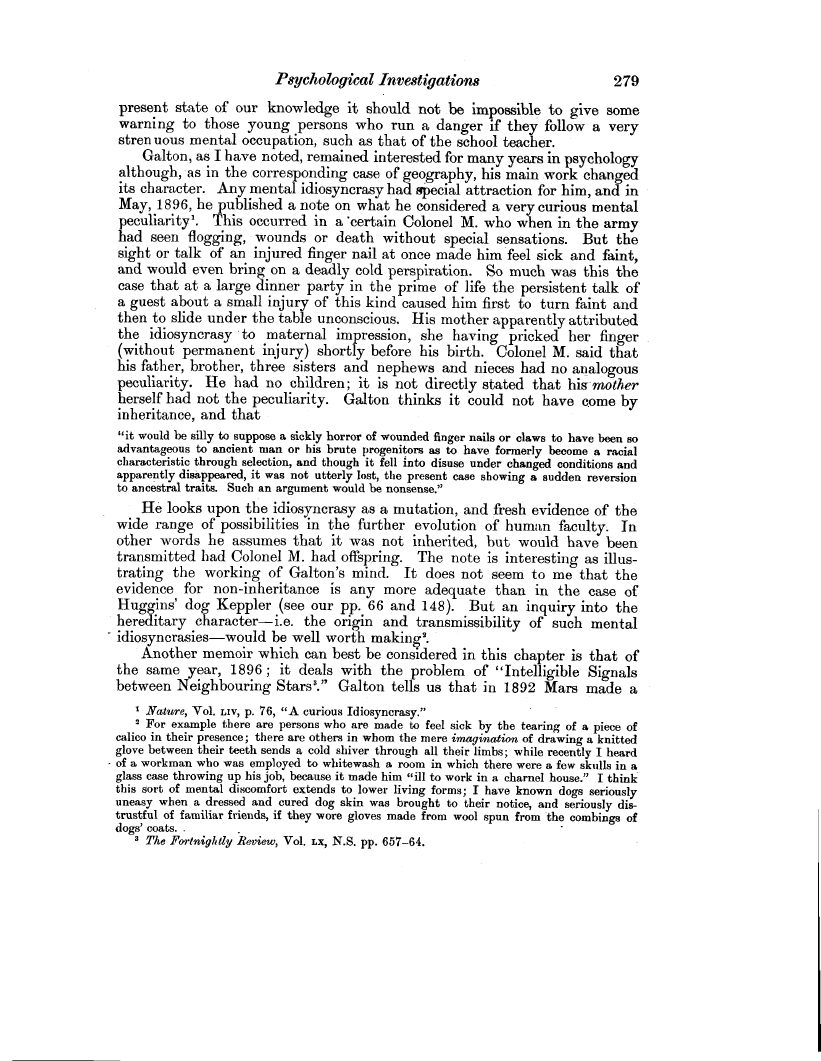Psychological Investigations 279
present state of our knowledge it should not be impossible to give some warning to those young persons who run a danger if they follow a very strenuous mental occupation, such as that of the school teacher.
Galton, as I have noted, remained interested for many years in psychology although, as in the corresponding case of geography, his main work changed its character. Any mental idiosyncrasy had special attraction for him, and in May, 1896, he published a note on what he considered a very curious mental peculiarity'. This occurred in a 'certain Colonel M. who when in the army had seen flogging, wounds or death without special sensations. But the sight or talk of an injured finger nail at once made him feel sick and faint, and would even bring on a deadly cold perspiration. So much was this the case that at a large dinner party in the prime of life the persistent talk of a guest about a small injury of this kind caused him first to turn faint and then to slide under the table unconscious. His mother apparently attributed the idiosyncrasy to maternal impression, she having pricked her finger (without permanent injury) shortly before his birth. Colonel M. said that his father, brother, three sisters and nephews and nieces had no analogous peculiarity. He had no children; it is not directly stated that his-mother herself had not the peculiarity. Galton thinks it could not have come by inheritance, and that
"it would be silly to suppose a sickly horror of wounded finger nails or claws to have been so advantageous to ancient man or his brute progenitors as to have formerly become a racial characteristic through selection, and though it fell into disuse under changed conditions and apparently disappeared, it was not utterly lost, the present case showing a sudden reversion
to ancestral traits. Such an argument would be nonsense."
He looks upon the idiosyncrasy as a mutation, and fresh evidence of the wide range of possibilities in the further evolution of human faculty. In other words he assumes that it was not inherited, but would have been transmitted had Colonel M. had offspring. The note is interesting as illustrating the working of Galton's mind. It does not seem to me that the evidence for non-inheritance is any more adequate than in the case of Huggins' dog Keppler (see our pp. 66 and 148). But an inquiry into the hereditary character-i.e. the origin and transmissibility of such mental idiosyncrasies-would be well worth making.
Another memoir which can best be considered in this chapter is that of the same year, 1896; it deals with the problem of "Intelligible Signals between Neighbouring Stars'." Galton tells us that in 1892 Mars made a
I Nature, Vol. LIV, p. 76, "A curious Idiosyncrasy."
2 For example there are persons who are made to feel sick by the tearing of a piece of calico in their presence; there are others in whom the mere imagination of drawing a knitted glove between their teeth sends a cold shiver through all their limbs; while recently I heard of a workman who was employed to whitewash a room in which there were a few skulls in a glass case throwing up his job, because it made him "ill to work in a charnel house." I think this sort of mental discomfort extends to lower living forms; I have known dogs seriously uneasy when a dressed and cured dog skin was brought to their notice, and seriously distrustful of familiar friends, if they wore gloves made from wool spun from the combings of dogs' coats. .
3 The Fortnightly Review, Vol. Lx, N.S. pp. 657-64.

